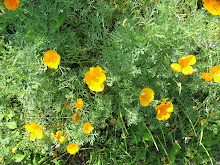As Allan, one of the early activists, recalled, one of the strategies to gain neighborhood support for using the vacant stable site as a community garden was to "make the place as pretty as we can." To back up, when the old riding rink was removed by the city in 1990, space opened up, with soil already enriched by years of sawdust and manure. Space was now exposed to sunlight, illuminating possibilities unforeseen. Where some neighbors saw free fertilizer, John Carroll had a vision for something different.
Much of what he started on the property in the early 1990s involved large plantings of wildflowers and perennials. As you can see in this photo, taken around late June 1994, they included hollyhocks, which self-seeded and spread to various locations in the garden over the next ten years, as well as daisies, day lilies, pinks, and poppies. Those of us who helped John in these common areas spent much of our time weeding out the mint that competed with these plants for nutrients and rescuing plants from the stranglehold of crown vetch.
The photo was taken from the location of the shed that you see in the background of the more current photo appearing under the blog title. I don't need to provide another photo from the same perspective for you to see how the garden has changed. In 1994, there were probably no more than ten neighbors gardening at the site, in plots located behind and to the right of these flower plantings. Now there are around 45 plots and a waiting list of gardeners hoping to get in on the action. Unfortunately, these flower beds no longer exist, though many of these varieties still live on in some of the gardeners' plots. Now there are more native perennial varieties taking root in an area behind from where this photo was taken. More on those and a continuation of the history of the MSG are forthcoming.



No comments:
Post a Comment